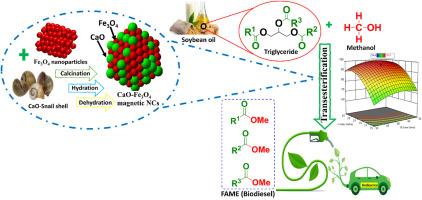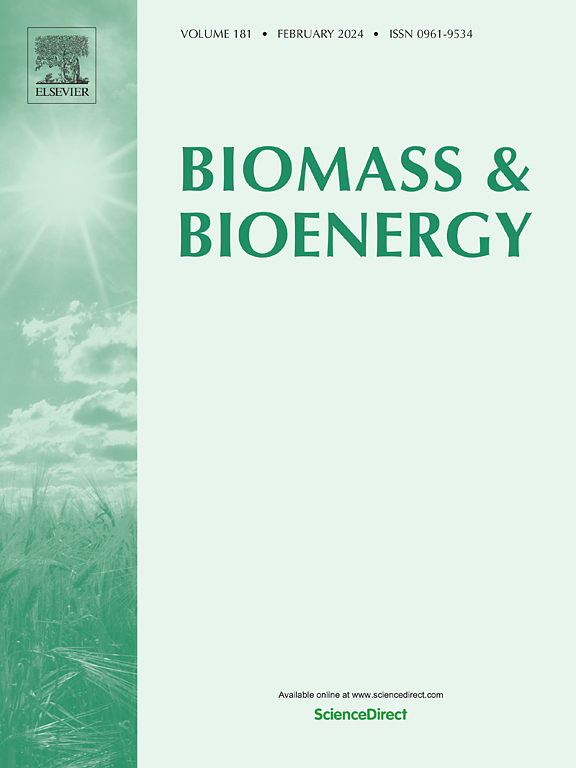Snail shell derived magnetic nanocatalysts for biodiesel production: Process optimization through response surface methodology, kinetics, and thermodynamic studies
IF 5.8
2区 生物学
Q1 AGRICULTURAL ENGINEERING
引用次数: 0
Abstract
In this study, calcium oxide-magnetite (CaO-Fe₃O₄) nanocomposites (NCs) were synthesized from waste inorganic biomass (snail shells) using sequential calcination, hydration, and dehydration processes. The synthesized catalyst was thoroughly characterized using various techniques, including XRD, FTIR, TGA, SEM-EDS, BET, XPS, CO₂-TPD, VSM, and ICP-OES analysis and applied to the transesterification of soybean oil to produce biodiesel. The reaction was optimized using response surface methodology, achieving a high biodiesel yield of 97.7 ± 0.2 % (98.0 ± 0.4 % conversion). The quality of the biodiesel was confirmed by comparing its physicochemical properties with ASTM standards. The transesterification reaction followed pseudo-first-order kinetics with an activation energy of 42.5 kJ mol⁻1. Furthermore, thermodynamic analysis showed that the process was endothermic (ΔH° = 39.13 kJ mol⁻1) and non-spontaneous. The catalyst was reused for up to seven reaction cycles, and the nature of the reused catalyst after the seventh cycle was thoroughly examined later in the study.

用于生物柴油生产的蜗牛壳衍生磁性纳米催化剂:通过响应面方法学、动力学和热力学研究优化工艺
本研究以废弃的无机生物质(蜗牛壳)为原料,采用煅烧、水合和脱水顺序合成了氧化钙-磁铁矿(CaO-Fe₃O₄)纳米复合材料(NCs)。利用各种技术,包括 XRD、FTIR、TGA、SEM-EDS、BET、XPS、CO₂-TPD、VSM 和 ICP-OES 分析,对合成的催化剂进行了全面表征,并将其应用于大豆油的酯交换反应以生产生物柴油。该反应采用响应面方法进行了优化,生物柴油产量高达 97.7 ± 0.2 %(转化率为 98.0 ± 0.4 %)。通过将生物柴油的理化性质与 ASTM 标准进行比较,确认了生物柴油的质量。酯交换反应遵循假一阶动力学,活化能为 42.5 kJ mol-1。此外,热力学分析表明,该过程为内热(ΔH° = 39.13 kJ mol-1)且非自发。该催化剂最多可重复使用七个反应循环,研究后期还对第七个循环后重复使用的催化剂的性质进行了深入研究。
本文章由计算机程序翻译,如有差异,请以英文原文为准。
求助全文
约1分钟内获得全文
求助全文
来源期刊

Biomass & Bioenergy
工程技术-能源与燃料
CiteScore
11.50
自引率
3.30%
发文量
258
审稿时长
60 days
期刊介绍:
Biomass & Bioenergy is an international journal publishing original research papers and short communications, review articles and case studies on biological resources, chemical and biological processes, and biomass products for new renewable sources of energy and materials.
The scope of the journal extends to the environmental, management and economic aspects of biomass and bioenergy.
Key areas covered by the journal:
• Biomass: sources, energy crop production processes, genetic improvements, composition. Please note that research on these biomass subjects must be linked directly to bioenergy generation.
• Biological Residues: residues/rests from agricultural production, forestry and plantations (palm, sugar etc), processing industries, and municipal sources (MSW). Papers on the use of biomass residues through innovative processes/technological novelty and/or consideration of feedstock/system sustainability (or unsustainability) are welcomed. However waste treatment processes and pollution control or mitigation which are only tangentially related to bioenergy are not in the scope of the journal, as they are more suited to publications in the environmental arena. Papers that describe conventional waste streams (ie well described in existing literature) that do not empirically address ''new'' added value from the process are not suitable for submission to the journal.
• Bioenergy Processes: fermentations, thermochemical conversions, liquid and gaseous fuels, and petrochemical substitutes
• Bioenergy Utilization: direct combustion, gasification, electricity production, chemical processes, and by-product remediation
• Biomass and the Environment: carbon cycle, the net energy efficiency of bioenergy systems, assessment of sustainability, and biodiversity issues.
 求助内容:
求助内容: 应助结果提醒方式:
应助结果提醒方式:


